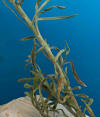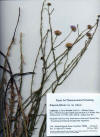|
Erigeron breweri
|
Erigeron concinnus
|
|
Erigeron divergens
|
Erigeron foliosus
var. foliosus |
|
Erigeron foliosus var.
foliosus
|
Erigeron foliosus
|
|
Erigeron glaucus
|
Erigeron sp.
|
|
Trees and Shrubs of Kern County (Sep 2012, July 2016) Erigeron. Annual to subshrubs, leaves often clustered near base, long tapered to base from elliptical blades above, or uniformly narrow linear, occasionally entirely elliptical, alternate on stems above base where gradually reduced to terminal flower heads from simple or branched stems. Flower heads usually with both rays and disc flowers, rays often blue, disk usually yellow; involucral bracts generally narrow, linear to sword-shaped. Cypsela with capillary bristles; achene portion carrot–shaped, often hairy, nerved. ~390 spp., circumboreal and neotropical mountains (Nesom, in FNA 20, 2006; of ~ 173 species in North America (Nesom in FNA 2006), although 46 noted to belong five paraphyletic groups; 21 used medicinally by native Americans (Moerman), 9 in Kern County with 4 additional varieties (Moe 2016), two described below to have woody roots, a third reported by Moe (2016), E. aequifolius H. M. Hall 1915 to occur at Owens Peak with reference to “Shevock,” but no CCH records for Kern County (accessed July 8, 2016); E. aequifolius differs from E. breweri by short glandular hairs on stems, occurring in rock crevices in the southern Sierra Nevada, 1500–2100 m (JM2).
Stems-leaves green, hairy or not, if hairy, the hairs pointing upwards (appressed
Stems-leaves gray green, with stiff hairs pointing downwards (var.
breweri) Erigeron breweri A. Gray 1866. Brewer’s fleabane. Perennial with many ascending to erect stems to 1 m from a woody root-rhizome complex, leafy stems simple bearing many alternative floral branches above, the stems with short deflexed hairs among others sharply bent in various directions; leaves alternate, spirally arranged, linear, 1–6.5 cm, abruptly rounded to apex, hairy. Flowers Jun–Sep, heads on peduncles arising at different levels but in a flat topped arrangement, involucral bracts in 3–5 ranks, green, relatively broad, boat-shaped to cuspidate apex, inner more flat, rounded to apex (var. breweri), or purplish along margins (var. jacinteus); rays numerous, 20–65, white, pink, blue or purple, disk flowers yellow. Coniferous forests and woodlands, montane chaparral below 10,000 ft, Oregon, California, Nevada, Baja California. Type from Yosemite Valley, Mariposa Co., 4,000 ft. Kern Co.: Six varieties of which four reported for Kern County (Moe 2016), but their distinction and distribution not clear, appearing to be only one or two in Kern County. Nesom (1992) recognized only var. breweri in Kern County, a “tall form” distinguished by the glandular involucral bracts, primarily collected from the Greehorn, Piute and Breckenridge mountains, 1767–2,332 m (CAS specimens annotated by Nesom, CCH, also referred to var. covillei (Cronquist 1947; Abrams & Ferris 1960; Twisselmann 1967). This included those collected by Twisselmann, which he referred to as Erigeron foliosus var. covillei (E. covillei Greene 1895) Compton 1934 = E. breweri var. covillei Nesom 1992, restricted to Inyo County (type from Coso Mountains, near Crystal Springs, same locality for Ephedra viridis). Variety jacinteus (E. jacinteus. H.M. Hall 1902) Cronquist 1947, distinguished by its creeping habit with stems ascending not more than 15 cm, and by its solitary heads, was previously recognized only from the San Jacinto (type), San Bernardino, San Gabriel and San Antonio mountains (Abrams & Ferris 1960; Nesom 1992), but also interpreted to occur in the Eastern Sierra Nevada bordering the Mojave Desert in Kern County on east slope of Owens Peak, 2500 m, Fraga et al., 7 Oct 2005, cited by Moe (2016); in CCH-RSA as var. covillei, duplicate UC1922149 reidentified by John Strothers to var. jacinteus, 13 Apr 2009, but geographically outside the range given by Keil & Nesom (2012, in JM2). Similarly, E. breweri var. bisanctus Nesom 1992, distinguished by ascending appressed hairs on stems, and described to occur only in the San Bernardino and San Gabriel mountains (Nesom 1992; Keil & Nesom in JM2), is reported by Moe (2016) for Kern County, citing specimens by various collectors from the San Emigdio Mts., Mt. Pinos and Breckenridge Mt. Erigeron foliosus Nuttall 1840 var. foliosus [includes var. stenophyllus (E. stenophyllus Nuttall 1847, replaced by E. nuttallii A. Heller 1898) A. Gray 1876]. Thread stemmed fleabane. Perennial to 1 m from a woody root, stems erect, with occasional branches shortly ascending near base and erect above, densely leafy from near base; leaves alternate and spirally arranged, thread-like, 1–6.5 cm, widening above the mid region to 1.5 mm, with pustulate hairs. Flowering May–Jul; flower heads solitary on peduncles in a flat topped arrangement, involucral bracts in 3–5 ranks; rays numerous, 15–60, blue to purple, disk flowers yellow. Widely distributed, Oregon through much of California to Baja California, below 9,000 ft. Generally herbaceous, 5 varieties in California; var. foliosus can have a woody root, mainly found in southern California chaparral and woodlands to Baja California. Kern Co.: Near Woody, Granite Station, Rattle Snake Grade in the Greenhorn Range, and in the Tehachapi Mts., 2.2 miles east of the Keene turnoff from Calif. Hwy 58 on Woodford to Tehachapi road, 731–2,332 m (CCH). References on Pharmacological Activity in Erigeron Meepagala K. M., G. Sturtz, D. Wise and D. E. Wedge. 2002. Molluscicidal and antifungal activity of Erigeron speciosus steam distillate. Pest Manag. Sci. 58(10):1043–1047. “The steam-distilled fraction of the aerial parts of Erigeron speciosus (Lindl) DC was tested for activity against strawberry plant pathogenic fungi Botrytis cinerea Pers ex Fr, Colletotrichum acutatum Simmonds, C fragariae Brooks, C gloeosporioides (Penz) Penz & Sacc, and the intermediate host snail Planobdella trivolvis that harbors the trematode, Bolbophorus confusus, that infests and causes severe infections in pond-raised catfish in the Mississippi Delta region of the USA. Bioautography on silica TLC plates demonstrated antifungal activity in the steam distillate. Preliminary bioassays of the steam distillate indicated the presence of phytochemicals toxic to P trivolvis. The bioactive compounds methyl 2Z, 8Z-deca-2,8-diene-4,6-diynoate and its 2E, 8E isomer were isolated by bioassay-guided fractionation and chromatographic techniques and identified by 1H NMR spectroscopy.” |
|











